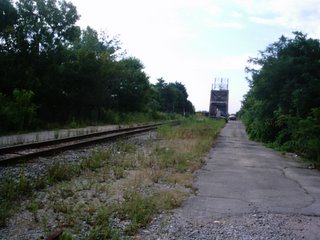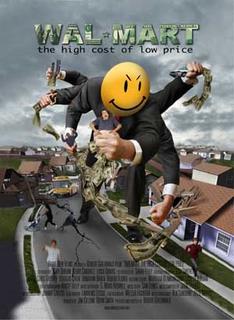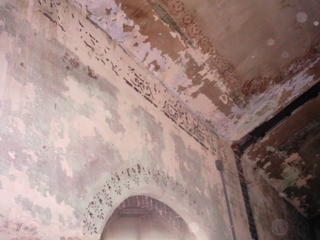
"Give us candy or we'll send you to the worst place of all ... where people get sent when they haven't been good ... to ... yesss ... SCRIBNER PLACE!!!
AAyyyyyyyeeeeeee ...
New Albany is a state of mind … but whose? Since 2004, we’ve been observing the contemporary scene in this slowly awakening old river town. If it’s true that a pre-digital stopped clock is right twice a day, when will New Albany learn to tell time?

"Give us candy or we'll send you to the worst place of all ... where people get sent when they haven't been good ... to ... yesss ... SCRIBNER PLACE!!!
AAyyyyyyyeeeeeee ...

Currently the pavement leads to nowhere ... but maybe ...
As for the river walk concept, it is widely understood that the biggest obstacle to completing such a loop is the Norfolk Southern Railroad, owner of the K & I Bridge, and the company’s fear of liability when people and trains share transport space.
A retired city councilman once told me that the railroad would be happy to yield on this point if either state agreed to pay for the necessary insurance, but warned me not to do something foolish like hold my breath.
Beyond that, can anyone connected with the recent history of the Greenway project provide an explanation for why it was designed for vehicular traffic, and not to be a pedestrian and bicycle path – which, after all, seems to fit the destination of “greenway” better than billowing exhaust fumes, motorcycles and automotive traffic that we’re told will be somehow controlled and restricted as to speed?
As a daily cyclist, color me skeptical about claims like these, although in fairness, it’s true that I’ve made it all the way through 2005 without garbage being thrown, obscenities being yelled, or evasive action being required to avoid a rampaging driver.
Wouldn’t the Greenway’s cost be far less if a new automotive bridge didn’t have to be built, and the existing trestles in Al Goodman’s Loop Island Wetlands could be used in the fashion of the Monon Trail in Indianapolis?
Ms. Bolovschak, recent commission appointee, if you’re reading: Do you think it’s too late to rethink the Greenway concept and make it more green, and less Dick Cheney?
xxxx
Big thanks to Ms. Bolovschak for this prompt Monday morning response:
"I would gladly hear from any of you who care to voice their opinion about the Ohio River Greenway. I contacted the Tribune about an open forum I will be hosting to discuss the topic. You’ll be reading about that soon."
 Looking for the perfect segue into a reminder about the forthcoming Wal-Mart movie spectacular in downtown New Albany?
Looking for the perfect segue into a reminder about the forthcoming Wal-Mart movie spectacular in downtown New Albany?David Duvall describes the facade, which is typical of warehouse buildings from the Federal period. The drawing to his left shows the view, circa 1900.
 Inside, three floors have been used for decades as warehouse space for Schmidt Furniture, and it would appear that the family-owned business is amenable to selling the building if the potential buyer will assist in downtown revitalization, i.e., if it becomes housing, retail or something other than what it is now.
Inside, three floors have been used for decades as warehouse space for Schmidt Furniture, and it would appear that the family-owned business is amenable to selling the building if the potential buyer will assist in downtown revitalization, i.e., if it becomes housing, retail or something other than what it is now.
 Many of the windows facing Main Street are still in place, covered with sheet metal on the exterior.
Many of the windows facing Main Street are still in place, covered with sheet metal on the exterior.

Here's the third floor, with ample light from the industrial windows even on a dull October afternoon. Looking south:

And back to the north:
 Few buildings in downtown New Albany have an unobstructed view of the Ohio River, but the third floor Reisz vista includes the river and the Louisville skyline.
Few buildings in downtown New Albany have an unobstructed view of the Ohio River, but the third floor Reisz vista includes the river and the Louisville skyline.
Did someone say "condo ready"?
(Parts three and four will be posted later Thursday afternoon, and will be backdated for sequencing)
The city of New Albany now owns the buildings as part of the Scribner Place land acquisition deal, and their precise future use is uncertain at this time, City development officials are hoping that a buyer can be found who will utilize the buildings in a way that is complementary to Scribner Place. Here are views of the interior of the stables portion, first looking north, then south:
Ready to restore an old window?
Following is a view on the tavern side, with wainscotting below and plaster above, and some remnants of old wallpaper.
To reiterate, the purpose of the field day was to learn about ways to achieve rehabilitation while satisfying requirements for tax credits. These views provide some perspective on possible uses, and also on the expense required to restore these long neglected structures; as in the cases of all three buildings that were visited, interiors have long since been compromised with the objective of using the buildings as storage space or for industrial applications.
Still to come: The Baptist Tabernacle.

The drawing shows how the original windows have been modified and cut down, and doors added to the front. In addition, an entire floor has been added atop these steel beams, without regard for the original proportions -- first added, then largely unfinished, so that the "floor" above is little more than wavy plywood sheets tied down to two by fours.
In addition, an entire floor has been added atop these steel beams, without regard for the original proportions -- first added, then largely unfinished, so that the "floor" above is little more than wavy plywood sheets tied down to two by fours. However, the ground floor does not prepare the visitor for the scene up higher, in what has become a large, open room atop the plywood, where decorative ceiling details can be glimpsed and some semblance of the church's original grandeur finally discerned.
However, the ground floor does not prepare the visitor for the scene up higher, in what has become a large, open room atop the plywood, where decorative ceiling details can be glimpsed and some semblance of the church's original grandeur finally discerned.

 The helter skelter effect of the deteriorating old and the slipshod new reminded me of certain places I'd visited in Communist Eastern Europe, where there'd been no money to restore buildings (like churches) deemed unimportant, and where thankfully no effort had been made to tear them down.
The helter skelter effect of the deteriorating old and the slipshod new reminded me of certain places I'd visited in Communist Eastern Europe, where there'd been no money to restore buildings (like churches) deemed unimportant, and where thankfully no effort had been made to tear them down.
In spite of such melancholy reflections, the tone of the day was upbeat, and the information dispensed fascinating. There are ways to use these buildings that are in keeping with the tone of downtown revitalization, and in such a fashion that the owner can receive tax credits at the same time.
It's matching the people with the opportunity, which is why real estate agents were in attendance. It's also about establishing an atmosphere conducive for potential investors, which is why you'll no longer find a link on NA Confidential to community web sites that don't represent the best this city can be.
As mentioned previously, I'll relay questions to the proper person -- just e-mail me privately.


 The four serving tanks will be moved from the brewery into a space being readied for their occupancy. Those familiar with the Sportstime seating area will recognize the now former game room.
The four serving tanks will be moved from the brewery into a space being readied for their occupancy. Those familiar with the Sportstime seating area will recognize the now former game room.
John and the good people from AAA Plumbing Doctor are cutting a floor drain today and tomorrow, and we'll do some waterproofing of the walls before removing two panes of the glass between the brewery and the seating area, and moving the serving tanks into their permanent home.
Special long-draw draft lines, a standard feature in most brewpubs, will connect the serving tanks with a draft station, which probably will be located in the area of Rich O's known as the (now former coffee room).
As if all this weren't enough for a chilly October morning, the roofers returned from a rain delay to resume work. Here they are, with the plumbers merrily jack-hammering beneath them:
 To top it off, two out of the three big weekly beer deliveries came in within minutes of each other. Once the new equipment is installed and working, it is our hope to slightly reduce the amount of beer purchased from outside, to increase the amount of house-brewed beer and be able to offer six to eight draft NABC beers at all times, and to have a proportion left over to sell to the outside account that I still can't divulge at this time, but which is well on its way to fruition.
To top it off, two out of the three big weekly beer deliveries came in within minutes of each other. Once the new equipment is installed and working, it is our hope to slightly reduce the amount of beer purchased from outside, to increase the amount of house-brewed beer and be able to offer six to eight draft NABC beers at all times, and to have a proportion left over to sell to the outside account that I still can't divulge at this time, but which is well on its way to fruition.
It would be nice to stop for the day ...
As we wait for the arrival of the truck that bears our fermenters and serving tanks, here’s a reminder of this week’s downtown historic district building tour and tax credit field day on Wednesday, Oct. 26.
Link to the original story: PHOTO UPDATE: Downtown historic district building tour and tax credit field day on Oct. 26.
Meanwhile, the Historical Preservation Commission's Ted Fulmore is posting helpful background information at his blog, Our History in New Albany:
Helpful info for Wednesday Workshop.
More info for workshop.
If your ear’s currently to the ground, you know that there’s an increasingly healthy buzz about downtown revitalization prospects. Let’s hope that Wednesday’s seminar contributes to the good vibes.
 Since we've lashed the Tribune for so long over the regular absence of weekend web site updates, we're delighted to report that today, Sunday's main stories are duly archived -- today, not Tuesday!
Since we've lashed the Tribune for so long over the regular absence of weekend web site updates, we're delighted to report that today, Sunday's main stories are duly archived -- today, not Tuesday!
Yes, that's right.
Six weeks later, the burned-out Sun-Sation salon looks exactly the same, still vaguely reminiscent of a scene from a war zone, except I noticed today that someone has thoughtfully wedged a beam between the sidewalk and the façade to keep a portion of the roof from falling completely down.
Yo, Steve L. and the Board of Public Works -- can you tell us why nothing whatsoever is being done about a structure that’s not only an eyesore, and a sad commentary for visitors to survey, but quite plainly poses a safety hazard to children (or drunks) who may be tempted to play in the ruins?
I'm sure there's an explanation.
 On Monday afternoon, we received word that the money's safely in the bank somewhere on Prince Edward Island, the customs paperwork is almost finished, and our new fermenters and serving tanks will be loaded and shipped within the next two days.
On Monday afternoon, we received word that the money's safely in the bank somewhere on Prince Edward Island, the customs paperwork is almost finished, and our new fermenters and serving tanks will be loaded and shipped within the next two days.

The Reisz Building (c. 1850) on Main Street:
and the Baptist Tabernacle (c. 1879) on East Fourth Street.
Lunch from Ermin’s French Bakery and Café will be $6.00.
This event is sponsored by:
Develop New Albany, an Indiana Main Street program
Historic Landmarks Foundation of Indiana, Southern Regional Office
City of New Albany Historic Preservation Commission
Please return your registration by Oct. 24 to Develop New Albany, 222 Pearl St., New Albany, IN 47150.
xxxxxxxxxxxxxxxx
NA Confidential cordially invites 3rd District Uncouncilman Steve Price to accompany us for the field day, and to cast a ceremonial "no" vote at the conclusion of the program.
(Committee member Tim Deatrick authors this report on Thursday night's meeting, and we thank him for taking the time to do so)
It took nearly three hours of spirited discussions, including commentary and questions from city councilmen Dan Coffey, Steve Price and Mark Seabrook with observations from Bill Schmidt, but at the end of the evening it was a consensus that this committee supports and recommends the passage of the interim fee ordinance at the next council meeting.
The issue of accurately assessing commercial properties was discussed and it was listed as the first priority in establishing a true rate structure after the interim fee is adopted. Regarding the city council concern that the interim fee should not be an 18-month process, the engineers feel that a 6-month window is more probable.
Despite the occasional issues of sanitation somehow coming up in this discussion, Chad McCormick and his team did an excellent job in keeping the committee on track to discuss the agenda and keep the politics to a minimum.
I am happy to report that the committee made major strides Thursday night and now the city council has unified voice from this committee that says loud and clear -- move forward on this ordinance, and get the program off the ground!




